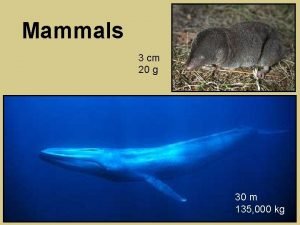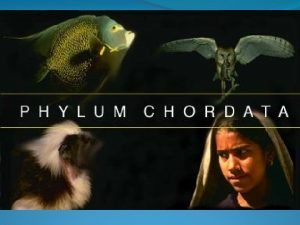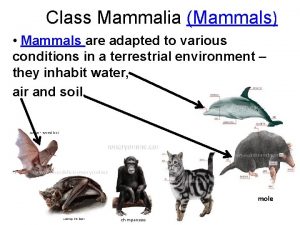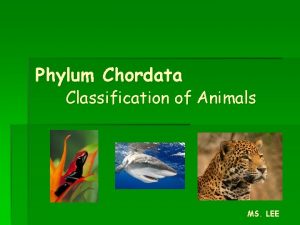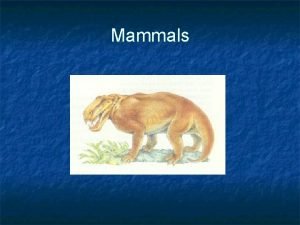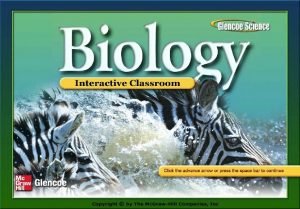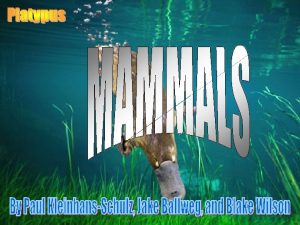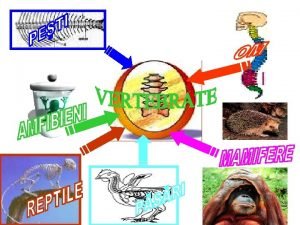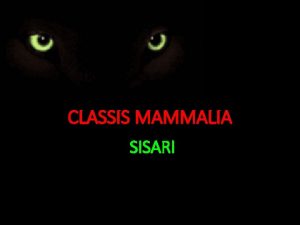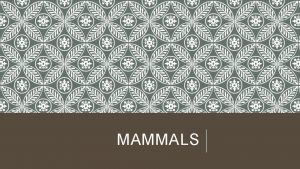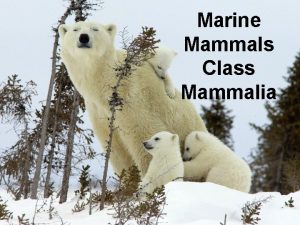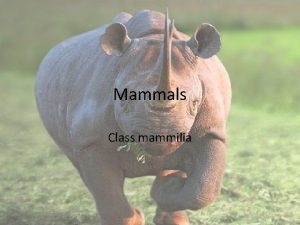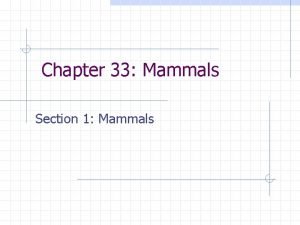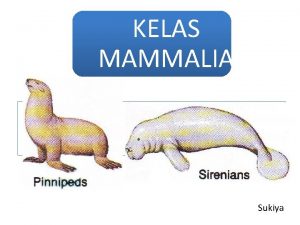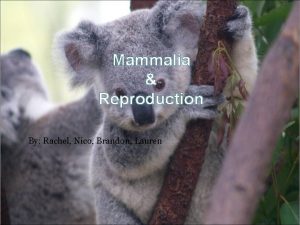Class Mammalia Ancestors of Mammals 300 m y














- Slides: 14

Class Mammalia

Ancestors of Mammals • 300 m. y. a amniotes split – Dinosaurs, birds, modern reptiles – Synapsids • Small – like lizards • Dimetrodon – Therapsids • Subset of synapsids gave rise to mammals • Endothermic, limbs under body, hair

Early Mammals • 1 st mammals and dinosaurs appeared 251 m. y. a • Triassic period • Size of mice, large eye sockets, specialized teeth adapted for feeding on insects • Cretaceous period (100 m. y. a) – Monotremes, Marsupials, Placental Mammals – Due to decline and extinction of dinosaurs mammals had abundant resources and habitat

Characteristics of Mammals • • • Endothermic Hair Completely divided heart (4 chambers) Mammary glands Single lower jawbone Specialized/Differentiated Teeth

Body Systems • Circulatory System – 4 chambered heart – Complete division of deoxygenated and oxygenated blood • Respiratory System – Large lungs with alveoli (air sacs) – Increased surface area increases gas exchange – Diaphragm • Muscle below rib cage that when contracted enlarges the thorax expanding the thoracic cavity

• Feeding – Differentiated teeth • • Incisors; used for cutting Canines; used for gripping, puncture, and tearing Premolars; used for shearing, shredding, cutting, grinding Molars; use for grinding, crushing, cutting – Herbivore, Carnivore, Omnivore, Insectivore, – Baleen • Thin plates of keratin hang from the skin of upper jaw of some whales

• Digestive System – Herbivores • Plant material is difficult to digest • Adaptations include rumen and cecum – Ruminants • Stomach made up of 4 chambers • Rumen – Symbiotic microorganisms partially digest the chewed material, then the material is regurgitated chewed again, swallowed again – Cows, deer, sheep, goats, giraffe – Cecum • Large sac branches from small intestine • Horses, zebra, rabbits, rodents, elephants

• Nervous System – High ratio of brain size to body size – Cerebrum • Outer region responsible for sensory organs, controls movement, regulated behavior, function for memory and learning • Echolocation

Development • Monotremes; lay 1 – 2 thin leathery eggs • Marsupials; develop within a pouch after “birth” • Placental Mammals; placenta and gestation – Gestation • • Whale 430 days Human 270 days Gerbil 21 days Horse 340 days • Parental Care • Milk

Classification • Three main groups of Class Mammalia – Monotremes (1 Order) – Marsupials (7 Orders) – Placental Mammals (18 Orders)

Order Monotremata • Found in Australia • Echidna (2 species) and Platypus • Platypus – Reptilian traits; Legs sprawl to sides, cloaca, no teeth – Mammalian traits; hair, mammary glands

Superorder Marsupialia • Found in Australia, South America, North America • Kangaroo, koala, opossum, • Pouch Animals

Placental Orders • Major Orders – Perissadactyla – Primate – Rodentia – Cetacea – Xenarthra – Lagomorpha – Carnivora – Proboscidea – Insectivora – Sirenia

Placental Orders • Minor Orders, 1% of Placental Mammals – Macroscelidea; elephant shrew – Pholidota; pongolins or scaly anteaters – Tubulidentata; aardvarks – Scandentia; tree shrews – Dermoptera; colugos or flying lemurs – Hyracoidea; hyrax
 Invertebrates classification
Invertebrates classification Pelycosaurs
Pelycosaurs Class mammalia characteristics
Class mammalia characteristics Class mammalia characteristics
Class mammalia characteristics Odd-toed ungulates
Odd-toed ungulates Family leporidae kingdom
Family leporidae kingdom Chordata classification
Chordata classification Carnassial apparatus
Carnassial apparatus Characteristics of mammals
Characteristics of mammals Characteristics of mammals
Characteristics of mammals Mammalia subclasses
Mammalia subclasses Increngatura cordata
Increngatura cordata Classis mammalia
Classis mammalia 300 300 400
300 300 400 200 300 300
200 300 300

